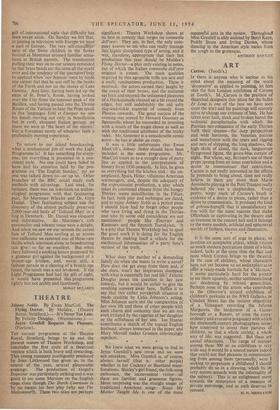ART
IF there is anyone who is unclear in his mind about the meaning of the word 'decorative' as applied to painting, let hint visit the first London exhibition of Carzou at Tooth's. M.Sarzou is the prettiest of theatrical designers (his decor for the ballet Le Loup is one of the best we have seen since the war) and his paintings will scarcely serve to change our estimate of him. He has taken over lock, stock and broken barrel the technical paraphernalia with which the Parisian neo-romantics of the early Thirties built their dreams—the deep perspectives and wide horizons, the Venetian piazzas and waterfronts with the spars and rigging and nets of shipping, the long shadows, the high skein of cloud, the dark, languorous foreground figure, the green-blue curtain of night. But where, say, Berman's use of these props sprang from an inner conviction and a desire to communicate that conviction, Carzou is. not really interested in the effects he pretends to bring about, does not really believe in them any more than Marie Antoinette playing in the Petit Trianon really believed she was a shepherdess. Every pretty, wispy mark of Carzou's brush is ' evidence of a desire to please, rather than a desire to communicate. It produces the kind of gebrauchsgrafik that is unsatisfactory to live with for the same reasons that make Offenbach so captivating in the theatre and so tiresome in the concert hall and it belongs to the more modish, artificial and ephemeral worlds of fashion, theatre and illustration.
It is the same sort of urge to please, to produce an acceptable object, which vitiates so much modern portraiture (most of which, indeed, lacks at the same time the flair and taste which Carzou brings to the thc atre). In the case of children, whose characters have not yet become so set andexplicit as to offer a ready-made formula for a 'likeness,' it seems particularly hard for the painter to see them squarely, neither sentimentalising nor deadening by relaxed generalities. Perhaps none of the artists who contribute to the Observer's second exhibition of children's portraits at the RWS Galleries in Conduit Street has the incisive objectivity of a Velasquez, recording the Infanta Margareta, the tenderness of a Gains- borough or a Renoir, or even the extra- ordinary and evocative poignancy with which the nineteenth-century photographers some- how contrived to invest their pictures of children, so that a whole society, a whole way of life, was suggested. But these are unreal objections. The range of manner among these 300 or so exhibitors is very wide and it would be a soured nature indecd that could not find pleasure in commission- ing from among them (personally, were seeking to perpetuate a childhood I should probably do so in a drawing, which by its very nature accords with the informality of the subject). This is an enlightened move towards the restoration of a measure of private patronage, and as such deserves to


































 Previous page
Previous page